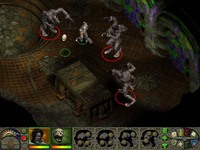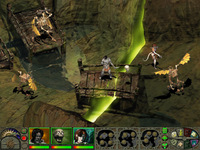|
|

|
PLATFORM
|
PC
|
BATTLE SYSTEM
|

|
INTERACTION
|

|
ORIGINALITY
|

|
STORY
|

|
MUSIC & SOUND
|

|
VISUALS
|

|
CHALLENGE
|
Moderate
|
COMPLETION TIME
|
20-40 Hours
|
|
OVERALL

|
+ Gripping, involving narrative
+ Tons to do
+ Well-written, interesting dialogue
- Combat isn't alluring
- Glitch gremlin attack!
- Small targeting icons
|
Click here for scoring definitions
|
|
|
Black Isle Studios crafted a fascinating title back in 1999 that used the Advanced Dungeons & Dragons universe in a way that became a gigantic expansion of it. Planescape: Torment focuses on telling a multifaceted story with an emphasis on dialogue over battle, and this choice serves it very well. The tale it tells is a fascinating one, with abundant opportunities for exploration to flesh out its grim world of Sigil. While it has definite flaws, they don't stand in the way of a truly mesmerizing experience.
Torment begins with a man being wheeled into a grisly mortuary. Instead of lying around and decomposing in the standard fashion of corpses, the man awakens with a floating skull nattering at him in an ingratiatingly amusing manner. The skull is named Morte, and the man's lack of any memory makes the information this talkative cranium provides very useful, especially when it comes to reading a message carved into his own back. Armed with the knowledge that he seeks a man named Pharod, and a journal of his own devising, the Nameless One sets out to leave the mortuary in search of his past. The frequently macabre happenings of the game are foreshadowed by this beginning, and the well-realized setting stays gripping at all times.
The arresting opening is promptly followed by further compelling content, as it quickly becomes apparent that the Nameless One's past is quite extensive, and many people remember him from years prior. His actions varied widely, and it seems that more than one personality operated his body as time passed. The root of this ailment lies in the condition that caused him to awaken in the mortuary, which is that his mortality has been removed to keep him from ever staying slain. This condition came with a price to his mental state, making the activities of his former lives quite unstable at times. Finding out what the Nameless One was up to before the game began is a fascinating pastime, and the overall narrative of Torment is enthralling from beginning to end.
Its core tale is just the beginning of Torment, which features an enormous compendium of characters with tales of their own. Just about every NPC the Nameless One encounters can be engaged in conversation to produce requests, some of which are of the basic fetch quest type, but most instead branch on dialogue choices to achieve a variety of outcomes. The scenarios are multifaceted, and it is possible to handle them in different ways depending upon the statistics in which the player chose to make the Nameless One proficient.
Even the fetch quests of Planescape: Torment are interesting because of the well-written and absorbing dialogue. Black Isle's writers deserve kudos for the many tantalizing events that take place, and for the compelling verve with which they come to life through text. Particular care is taken to describe the surroundings using vivid language, and while a pretty picture is rarely painted of the fetid areas and filth-ridden people that populate the majority of the game's locales, none of it comes across as bland. This is all the more impressive when the sheer quantity of text in the game is considered, making the occasional typo completely understandable as Torment's written component could fill a sizable book. Considering the graphics are adequate but no more, the marvelously descriptive words are an excellent means of visualizing the world in a different way.
 Ah, fiends. They hit hard and don't die easily. Good thing they're trying to kill someone who can't die.
Ah, fiends. They hit hard and don't die easily. Good thing they're trying to kill someone who can't die.
|
|
Completing the multitude of quests in Torment is not simply rewarded with fascinating things to read, but also with experience. Vast quantities of experience are awarded for taking the time to find a woman willing to kill a spurned wife's husband or solving a skeleton's riddles, just as examples of the things that can transpire. It is easy to gain enough experience for repeated levels just by partaking of dialogue trees and fetch quests.
Gaining experience in the traditional way of killing things is much less attractive by comparison. Fighting in Torment is a simple affair of choosing a target and directing either one or all characters in the party to rush over and bash it until one side is dead. Very little thought is required, save the need to occasionally recognize that the enemies are far too powerful and order a retreat. Areas filled with foes require some patience on the player's part in order to select a certain target, due to the fairly small targeting area and the clusters of enemies that accumulate. Fighting serves its purpose, but the ample experience rewards that can be attained from talking to people make battle a less appealing prospect. Combat also takes up a much smaller part of the game than the rewarding dialogue branches.
The tiny, constantly-moving icon by which a target is selected in battle is quite an annoyance, and it is coupled with another tiny icon that must be selected whenever an enemy has divulged something with its death. The cursor must be exactingly precise to pick up these little things, and collecting all the loot from a battlefield is likely to try one's patience. Using and holding items is somewhat cumbersome but easily understood, except if a character dies. The Nameless One will always revive later with his inventory intact, but any other character will drop almost everything being held and be forced to pick it up again if revived. This mechanic may be more realistic than letting a new corpse's fingers magically stay attached to everything it held, but it's an enormous pain to deal with, providing an excellent incentive to avoid combat when possible. Simply running away from enemies is usually easy to do, and eliminates most of this hassle.
At least the Nameless One has plenty of options available when it comes to combat. While he begins as a fighter, a point is granted with every level gained to customize his stats, and he can become a thief or mage rather easily during the game, then switch to something else as desired. Though the Nameless One has far more opportunities for customization than the people who join his party, they aren't fixed in their upgrades either, with Annah in particular having considerable leeway for how to grow in her thief abilities. As stealing from people and their locked fixtures is a useful ability during the lion's share of the game that is not fighting, this makes her growth rather important.
 90 years later, John R. Neill's illustrations were finally animated.
90 years later, John R. Neill's illustrations were finally animated.
|
|
Throughout Torment the Nameless One will just keep resurrecting after being killed in combat, though in a location not of the player's choosing. His companions can be killed, but the Nameless One has an ability to revive them at one HP when necessary. Save for a few parts in which the player can make it impossible to complete the game via some crazy decisions, it is only in the final area of the game that getting a Game Over is possible by getting killed, and until that time taking advantage of the fact that enemies do not regain HP if the party is taken out is easy to do. Finding the right sequence of events necessary to progress will prove more arduous than the relatively infrequent combat, but the game keeps a journal of the events transpiring so that the player won't have to constantly rely upon memory alone. Torment also automatically saves every time the action shifts to a new area, along with letting the player manually save except when under direct attack. Multiple dialogue options in each area are a common occurrence, so manually saving is very useful.
The constant saving is extremely fortunate due to quite a few glitches that like to appear. The worst of these crashes the game upon entering certain areas, necessitating a retry. Smaller bugs also appear, most prominently when the usual icon that marks the effect of clicking the mouse vanishes for awhile, and a few quests that cannot be completed if outside events are triggered. They're not unmanageable, but the glitch issues will frustrate all they afflict &emdash; until some more engrossing dialogue appears to alleviate this.
The music of Planescape: Torment is an atmospheric thing, with compositions that draw attention to themselves being relatively few. Instead the sound mix is used to great effect, letting the inclement noises of streets and people about their business do the job of setting the mood. Voices of NPC characters are used to lend further gravity to the environs being explored, and they do so superbly. A comparatively small percentage of the dialogue spoken by the main characters is actually vocalized, but the performances of the words they do externalize are uniformly fine, with Morte's quips being a source of frequent amusement.
Planescape: Torment may have an abundance of bugs and interface issues that are downright obtrusive, but somehow none of that matters too much when the fascinating world of Sigil and the planes it connects to are being explored. The incredibly well-realized and compelling tale put together by Black Isle serves as a great goad to keep playing, and it is a testament to the writers' skills that even what are technically fetch quests stay interesting throughout. I've never been much of a PC gamer for any genre, but this has me thinking about all the riches I have yet to experience on the platform.
Review Archives
|









